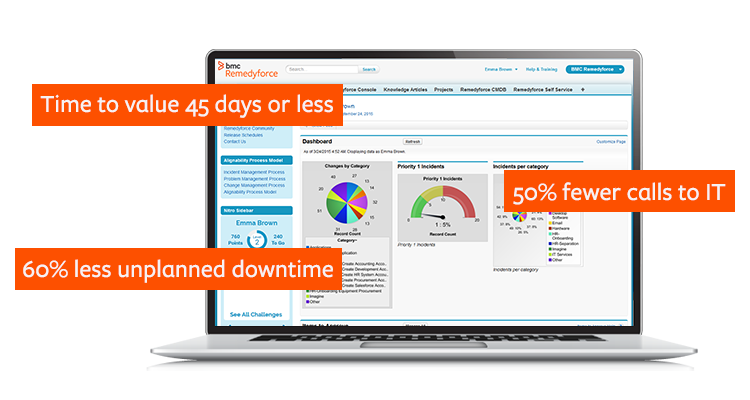In this Run and Reinvent podcast, Andy Hardwick, director of global service management at Arcadis, chats with Jules Murray, senior business relationship manager at BMC, about how to provide a consistent approach to IT service management across a global customer audience. Below is a condensed transcript of their discussion.
Jules Murray: Could you tell us a bit about Arcadis for those who maybe are not familiar with your organization? And maybe a bit about the customers that you serve?

So, some of the examples, certainly within the U.K., some of the projects that we would work on that people would be familiar with are things like the HS2 rail project and the Manchester Airport expansion. So, they’re the kind of projects we would get involved with, and usually it’s anything that can be built or designed. Also, natural assets, which is water management – that kind of thing. In total, there are 27,000 people within Arcadis, and we’re actually in over 70 countries, and we have revenues of EUR 3.3 billion.
Jules: Before using BMC Remedyforce, what set of support tools where you using for IT service management across your business?
Andy: A variety of different tools. Arcadis have grown through acquisition, and each new acquisition brought its own IT department with its own view of IT support and their own ITSM tools usually. So, we had 42 different countries, 42 different IT teams, and pretty much 42 different ways of providing IT support. So, some teams had ITSM tools as we would see them, such as TOPdesk and SCSM.
But all the teams didn’t have any specific ITSM tools at all, so they were using things like SharePoint or maybe even Outlook mailboxes. So, that obviously resulted the inability for us to have a consistent view of what was happening. We had little visibility and certainly no standard processes. And then, obviously, one decision that was made – this happened by Arcadis in the U.S. – was to move towards Remedyforce.
Jules: Had they been using Remedyforce for some time previous to that, then?
Andy: They started using it in 2013. So, the decision was made in 2013 to move towards Remedyforce. Previously, they had used SCSM, which is part of the Microsoft suite. So, they were using that and weren’t entirely happy. And obviously, they made the decision to move towards Remedyforce.
Jules: Did they feel Remedyforce was going to give to the more global business side of things that they found of benefit to themselves in the U.S.?
Andy: So, in actual fact, I don’t think there was ever any vision that it would be used globally. It’s really grown quite organically. So, Arcadis bought it in the U.S., and they were happy to use it. And then as other regions sort of were looking for other tools as well, the U.S. region provided guidance and said, “Well, actually, we think Remedyforce is probably a good fit. It seems to deliver what we want to do.”
So, to that point, it was really became the de facto standard that we would move towards Remedyforce as a global sort of platform. And that’s when I became involved. So, the U.K. were targeted to roll out Remedyforce within 2014. At that point, I joined the Remedyforce team and started putting together the process for rolling that out globally.
Jules: Did you start small with certain objects being implemented or was it more of a kind of a Big-Bang-type approach that you adopted?
Andy: I think somewhere in the middle, to be fair. Because the U.S. already had experience of using it for about a year at that point, we started with probably a few different modules.
So, certainly, incident was the big one, which probably is for most people. So, we had incident management set up. But we also had knowledge base articles right from the start. We used the CMDB to a small extent right from the start. And then, we grew the functionality from there.
Change management was one that we used fairly quickly and the self-service portal. And we’ve carried on now. So, pretty much every one of the main features within Remedyforce, we are currently using.
Jules: As you’ve rolled this out globally, obviously, you need to be administering this system in a consistent manner. How do you go about doing that when you’re so widely spread?
Andy: We have changed that model quite a few times. I’ve personally been administering Remedyforce for over five years now, so I’m fairly comfortable with the layout and what needs to be done when. However, as new people join the teams, we have found that quite difficult. There’s quite a big learning curve there in some aspects.
So, for example, it’s not always easy to see what permissions you will give. So, permissions can be split between profile permission sets, roles, and accounts. And it’s not always easy to see which ones you need to change to set the appropriate permissions. So, initially, we had a team of administrators globally that sort of met on a weekly basis and agreed what would be done, but we pretty much really looked after their own areas. So, we have someone in the U.S. looking after the U.S. and someone in Europe looking after Europe, but on a standard theme.
We found, though, that that’s – we’ve outgrown that model as we’ve moved towards a more global IT offering anyway. So, what we try to do now is split it now into functionalities. So, we have certain people that focus more on the self-service forums and the knowledge articles and making sure that that kind of thing is working well. Then we have more traditional developers that are actually doing some of the coding and creating things in the background with code and triggers and things like that. So, we’ve tried to split it into different skill sets, really.
Jules: Does that mean if you’re kind of enabling your developers to do that coding that you’re finding you can do most of the administration of the system that you need in house now?
Andy: Absolutely. I would say, when we first started, we were going out to partners for probably 50% of what we were doing at that point. But now it is very rare that we would go out to a partner. We’ve built that skill and that knowledge up internally over the last five or six years.
Jules: If we look a bit more at your customer base, whether that be internal customers or external, what’s the kind of perception of Remedyforce and your other supporting tools in relation to IT service management? Has it been adopted well?
Andy: I think, generally, the business and our customers are blissfully unaware of Remedyforce’s switch. They don’t come to us and say, “Remedyforce isn’t working.” But one of their main interactions, for example, would be through the IT self-service portal. So, they know that this is a self-service portal, and they know that they can go there to interact with IT. And the fact that we have 27.5% of all our tickets flood through that channel now seems to suggest that customers are fairly happy with that.
So, they log in, they request services or they log incident tickets or they check the progress of their tickets, and they’re doing that on the – every single day. So, while we’re not getting feedback directly about Remedyforce, we aren’t getting any complaints saying that self-service isn’t working or that they’re not able to interact with us in that way. So, I think that that probably speaks for itself, really.
Jules: If they use the self-service, is that a mixture of incident raising and service requests? Or is it predominantly one or the other?
Andy: It’s both. And I would say it’s probably a fairly even mix. So, we have been trying to increase our self-service capability over the last few years to give more offerings. So, we’ve spent quite a lot of time and effort making sure that we’ve got service request definitions available that people can go in there and request the services that they’re wanting. And we’re trying to increase that on a daily basis.







